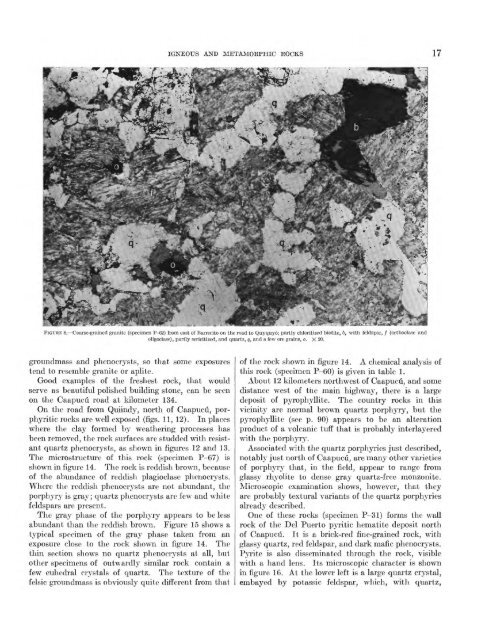Geology and Mineral Resources of Paraguay A Reconnaissance
Geology and Mineral Resources of Paraguay A Reconnaissance
Geology and Mineral Resources of Paraguay A Reconnaissance
- No tags were found...
You also want an ePaper? Increase the reach of your titles
YUMPU automatically turns print PDFs into web optimized ePapers that Google loves.
IGNEOUS AND METAMORPHIC ROCKS 17FIGURE 8. Coarse-grained granite (specimen P-62) from east <strong>of</strong> Barrerito on the road to Quyquyo; partly chloritized biotite, 6, with feldspar, / (orthoclase <strong>and</strong>oligoclase), partly sericitized, <strong>and</strong> quartz, g, <strong>and</strong> a few ore grains, o. X 20.groundmass <strong>and</strong> phenocrysts, so that some exposurestend to resemble granite or aplite.Good examples <strong>of</strong> the freshest rock, that wouldserve as beautiful polished building stone, can be seenon the Caapucu road at kilometer 134.On the road from Quiindy, north <strong>of</strong> Caapucu, porphyriticrocks are well exposed (figs. 11, 12). In placeswhere the clay formed by weathering processes hasbeen removed, the rock surfaces are studded with resistantquartz phenocrysts, as shown in figures 12 <strong>and</strong> 13.The microstructure <strong>of</strong> this rock (specimen P-67) isshown in figure 14. The rock is reddish brown, because<strong>of</strong> the abundance <strong>of</strong> reddish plagioclase phenocrysts.Where the reddish phenocrysts are not abundant, theporphyry is gray; quartz phenocrysts are few <strong>and</strong> whitefeldspars are present.The gray phase <strong>of</strong> the porphyry appears to be lessabundant than the reddish brown. Figure 15 shows atypical specimen <strong>of</strong> the gray phase taken from anexposure close to the rock shown in figure 14. Thethin section shows no quartz phenocrysts at all, butother specimens <strong>of</strong> outwardly similar rock contain afew euhedral crystals <strong>of</strong> quartz. The texture <strong>of</strong> thefelsic groundmass is obviously quite different from that<strong>of</strong> the rock shown in figure 14. A chemical analysis <strong>of</strong>this rock (specimen P-60) is given in table 1.About 12 kilometers northwest <strong>of</strong> Caapucu, <strong>and</strong> somedistance west <strong>of</strong> ttie main highway, there is a largedeposit <strong>of</strong> pyrophyllite. The country rocks in thisvicinity are normal brown quartz porphyry, but thepyrophyllite (see p. 90) appears to be an alterationproduct, <strong>of</strong> a volcanic tuff that is probably interlayeredwith the porphyry.Associated with the quartz porphyries just described,notably just north <strong>of</strong> Caapucu, are many other varieties<strong>of</strong> porphyry that, in the field, appear to range fromglassy rhyolite to dense gray quartz-free monzonite.Microscopic examination shows, however, that theyare probably textural variants <strong>of</strong> the quartz porphyriesalready described.One <strong>of</strong> these rocks (specimen P-31) forms the wallrock <strong>of</strong> the Del Puerto pyritic hematite deposit north<strong>of</strong> Caapucu. It is a brick-red fine-grained rock, withglassy quartz, red feldspar, <strong>and</strong> dark mafic phenocrysts.Pyrite is also disseminated through the rock, visiblewith a h<strong>and</strong> lens. Its microscopic character is shownin figure 16. At the lower left is a large quartz crystal,embayed by potassic feldspar, which, with quartz,
















